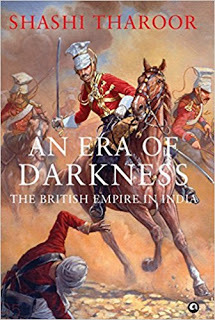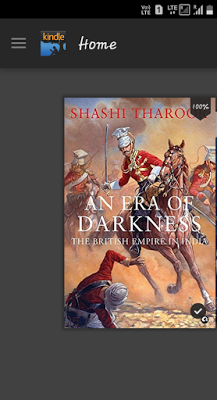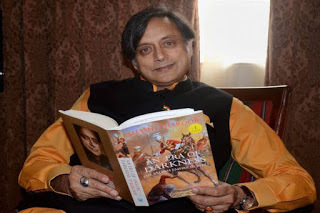
In my reading experience, present one is totally different and hard, though while reading an English author, I never ever opened a dictionary to understand the vocabulary but since I begin with An Era Of Darkness by Shashi Tharoor, damn, It’s provoked me to keep the dictionary open all the time till I finished the book and write my review. Usually I don’t read Shashi Tharoor but when I was searching for British India on Google, Google instantly displayed An Era Of Darkness – The British Empire In India by Shashi Tharoor and Apparently, Shashi Tharoor is the literary genius and a giant among Indian writers. A good and successful politician in his constituency in Kerala and a well-known speaker on international level.
Recently one of his speech gone viral on various social media platforms Shashi Tharoor’s Scalding Oxford Union Speech Against Colonial Britain, For this speech Tharoor got praised by various people and got laud by our present Honorable Prime Minister of India but why, Tharoor hadn’t mentioned the name of PM. If history interests you, you will simply love this book. If it doesn’t, you may like it even more as the book may spark an interest in you for history.
British rule was benign and considerate, author Tharoor’s book will come as a welcome Indian contribution in striking back at the Empire with details of the actual lived truth of colonialism. A brilliant and well researched book talk about a disturbing account of colonial rapacity and brutality.

I feel very sad and unfortunate for the harsh destiny of my country in early centuries and How Indians were suppressed and oppressed by British and Mughal emperors. Author described it in his critical words. Tharoor highly impacted on a word Raj, which narrates the sad tale of our forefathers who worked like an ass but couldn’t even get their honest wage instead they had been looted and killed, British were not providing them a single time meal to eat and get energy, in their own country they being enslaved by foreign regime.
Author is talking about a reparation if we sought for 200 years, will be fine if British say sorry rather than cash, thus author is big and golden hearted. An Indian commentator suggest him if compute what a fair sum of reparations would amount to, came up with a figure so astronomical—$3 trillion in today’s money—that no one could ever reasonably be expected to pay it. (The sum would be larger than Britain’s entire GDP in 2015.)
And praised the Prime Minister Justin Trudeau, did in 2016 when he apologized on behalf of Canada for the actions of his country’s authorities a century earlier in denying permission for the Indian immigrants on the Komagata Maru to land in Vancouver, thereby sending many of them to their deaths.
The British ‘takeover was facilitated and encouraged by Indians, how our own people or prince during that time Faustian bargain to protect their wealth and their comforts in exchange for mortgaging their integrity to the British and sacrificed their own people to death by British. There were other well-known Indian supporters of Empire, most notably the Bengali intellectual. All these people reminding me an old Hindi saying (From Ramayana) – An insider does the maximum damage. On the other hand an American historian and philosopher, Will Durant, criticize the and deliberate bleeding of India and wrote astonishment and indignation in his book The Case for India.
if we talk about Britain’s Industrial Revolution was built on the destruction of India’s thriving manufacturing industries. British found a company known as The East India company to loot and rob India in systematic and professional manner. Rural poverty was a direct result of British actions. who drove down rural wages. Weather or drought reduced their agricultural work, there was no back-up source of income from cloth. weavers lost their job or replaced by using a modern machinery thus, merely the victims of technological obsolescence. it also talk about the huge popularity of Indian made textiles. And extracted from India approximately £18,000,000 each year between 1765 and 1815
It was a time when peasants were impoverished by punishing tax laws and driven out of their lands and forced into deportation as indentured labor to far-off lands and made to suffer and die in recurrent famines.

Taxation by the Company—usually at a minimum of 50 per cent of income—was so onerous that two-thirds of the population ruled by the British in the late eighteenth century fled their lands. Durant writes that ‘[tax] defaulters were confined in cages, and exposed to the burning sun; fathers sold their children to meet the rising rates’. Unpaid taxes meant being tortured to pay up, and the wretched victim’s land being confiscated by the British. The East India Company created, for the first time in Indian history, the landless peasant, deprived of his traditional.
Diamonds escaped the confinement of traditional sources of wealth for something that could be acquired by colonial enterprise rather than traditional inheritance. Fifteen years after he had brought the diamond from India, Thomas Pitt sold it to the Regent of France, the Duc d’Orléans, for the princely sum of £135,000, almost six times what he had paid for it. Colorfully painful detail the violation of Bengali women by the British-assigned tax collectors—‘they were dragged out, naked and exposed to the public view, and scourged before all the people…they put the nipples of the women into the sharp edges of split bamboos and tore them from their bodies.
No wonder the nineteenth-century Indian nationalist Dadabhai Naoroji found evidence even in the published accounts of the British empire to evolve his ‘drain theory’ of extraction and indict the colonialists for creating poverty in India through what he diplomatically termed their ‘unBritish’ practices. Naoroji argued that India had exported an average of £13,000,000 worth of goods to Britain each year from 1835 to 1872 with no corresponding return of money; in fact, payments to people residing in Britain.
-
In 1700, India’s GDP was 27 per cent of the world GDP while in 1947, it had come down to 3 per cent. Just to put things in perspective, in 1600, Britain’s share of the global GDP was 1.8 per cent.
-
Between 30-35 million Indians died of starvation during the British Raj.
-
In the first decades of the twentieth century, 8000 British officers in India earned £13,930,554 each year, while over the same time, 130,000 Indians in govt. service earned £3,284,163 pounds
If these funds had been invested in India they could have made a significant contribution to raising income levels. Dadabhai Naoroji—who in 1892 became the first Indian elected to the British House of Commons, there to argue the case for India in the ‘mother of parliaments’
When Jamsetji Tata tried to set up India’s first modern steel mill in the face of implacable British hostility at the turn of the century (he began petitioning the British for permission in 1883, and raised money
producing. It’s a pity he didn’t live to see the descendants of Jamsetji Tata taking over what remains of British Steel, through Tata’s acquisition of Corus in 2006.
Over most of the subcontinent. The same impulse is also manifest in Indians vision of their own nation, as in the ancient epics the Mahabharata and the Ramayana, which reflect an ‘idea of India’ that twentieth century nationalists would have recognized. Lord Rama’s journey through India and his epic battle against the demon-king of Lanka reflect the same national idea. The vision of Indian unity was physically embodied by the Hindu sage Adi Shankara, who traveled from Kerala in the extreme south to Kashmir in the extreme north and from Dwarka in the west to Puri in the east. The great nationalist Maulana Azad once remarked upon how, at the Haj, all Indians were considered to be from one land, and regarded themselves as such.
The British Raj is scarcely ancient history. It is part of the memories of people still alive. According to a recent UN Population Division report, the number of Indians over the age of eighty is six million: British rule was an inescapable part of their childhoods. If you add to their number, their first-generation descendants, Indians in their fifties and sixties, whose parents would have told them stories about their experiences of the Raj, the numbers with an intimate knowledge of the period would swell to over 100 million Indians.
But the facts tell a stunning tale of exploitation and destruction. Let us look at some of them:
– India was a prosperous nation in the 18th century as documented by even the East India company’s own men like Robert Clive, Macaulay and others. India’s share then of the world economy was 23%, as large as all of Europe put together. By the time the British left India in 1947, it was 3%.
– When Britain left India in 1947, India had a literacy of 16%, an average longevity of just 27 years and 90% of the population were in poverty.
– Between 1757 and 1900, the British per capita GDP increased in real terms by 347% while that of the Indian by a mere 14%.
– India experienced recurrent devastating famines due to the ruthless economic policies enforced by Britain. At least eleven major famines were recorded in different parts of India between 1770 and 1944. About 30 -35 million Indians died in these famines. To put it in perspective, Tharoor quotes author William Digby, who points out that in the entire 107 years between 1793 and 1900, only an estimated five million people had died in all the wars around the world combined, whereas in just ten years 1891-1900, 19 million had died in India in famines alone.
– Economist Paul Baran calculates that 8 percent of India’s GNP was transferred to Britain each year.
– India exported to Britain £13m worth of goods each year from 1835 to 1872 with no corresponding return of money.
– The salary of the British Secy of State for India in 1901, paid for by Indian taxes, was equivalent of the average salary of 90000 Indians.
So, how did Britain manage to bring about these horrible outcomes? It was done by employing the following methods:
– allowing tariff-free exports of British goods to India
– Fixing standards in such a way that would make Indian manufactured goods unattractive in global markets
– applying import barriers on Indian manufactured goods
– Increasing India’s debt burden by manipulating the currency
– destroying competition, thereby preventing Indian businesses from challenging British ones and ensuring their monopoly
There are no dearth of apologists of British raj who would credit Britishers for giving India its unity, the railways, the foundation of Parliamentary Democracy, The modern civil laws, The English language, the infrastructure and what not but here Tharoor demolishes each one of these notions with reason and logic.
Completely factual. For proof, refer the Bibliography, several of the books listed there. There is extensive evidence available in the form of period documents, which has been referenced by the authors of all these books.
Advertisements Share this:




